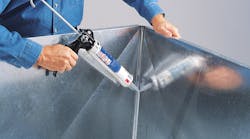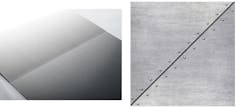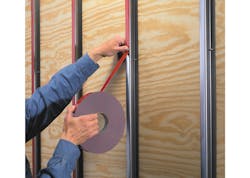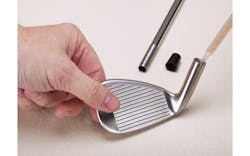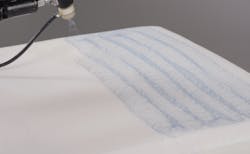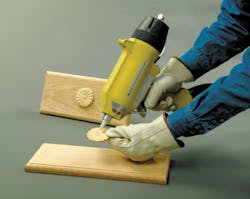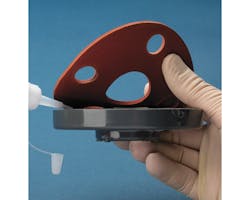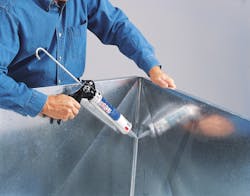Adhesives Expand Fastening Techniques in Industrial Assemblies
Download this article as a .PDF
For as long as humans have been using tools, they have found creative ways to mechanically fasten different materials with ropes, pegs, and wedges. After about a few thousand years of perfecting the art of fastening, someone invented the first adhesive: some birch-bark tar that could bond rocks together. The portfolio of available adhesives has since evolved into a textbook of everything from pressure sensitive adhesive (PSA) tapes to structural-strength curing adhesives.
To compare these various attachment methods—mechanical, thermal and adhesive bonding—it’s important to first consider the advantages and disadvantages of each. Certainly, each method has applications to which it is very well suited.
Mechanical Fasteners
Mechanical fasteners were the first to emerge for the same reasons that they are still used widely today. They are intuitive to use and require little, if any, cleaning or preparation on the parts being joined. Mechanical fasteners create strong joints immediately, many of which can be removed when needed. They also come with lower labor rates compared to other methods, such as thermal attachment (e.g., welding, soldering, and brazing).
However, mechanical fasteners have their limitations. Many require that the surface of one or more parts being joined be punctured. This penetration distorts the parts with a visible bond line and possible harm to painted surfaces. Distinct attachment points also concentrate stresses that increase fatigue on the joint and may contribute to premature failure. And mechanical fasteners do not isolate dissimilar materials, which may lead to corrosion.
Thermal Fastening
Thermal attachment offer advantages similar to mechanical fasteners’. They promise a quick process without need for clamping time or curing, and the raw materials are inexpensive. The wide acceptance of welding and soldering in the marketplace for decades has created a broad, common level of understanding for designers and manufacturers.
However, assemblies bonded thermally must use similar materials, and they often require relatively thick substrates (especially compared to those being joined with mechanical fasteners). The joints are strong, but they are also difficult to disassemble, rework, or repair. They can also create aesthetic concerns such as discoloration, distortion, or read-through. The cost of thermal attachment can be quite high and include the costs of skilled labor, energy, and safety (personal protective equipment, insurance, etc.).
Adhesives
Adhesive and tape bonding, the latest method of assembly to emerge, offers unique advantages to an assembly. It joins dissimilar materials, oftentimes with thinner substrates than are possible capable with mechanical or thermal attachment. The elimination of stress concentration also preserves the surface, improving aesthetics, preventing thermal degradation, and maintaining protective coatings. Adhesives also bond and seal joints simultaneously, potentially removing other process steps and damping vibrations in the final part.
The numerous advantages come at a price, often in the raw-material cost. Adhesives can also be relatively complex in terms of preparation, application, and curing, resulting in a lack of familiarity among engineers and standard specifications. Disassembly is also a challenge, especially in part testing where non-destructive testing is not widely accepted.
Many adhesives and tapes complement the advantages and disadvantages of mechanical and thermal attachment. PSA tapes or hot melt adhesives allow faster assembly than mechanical fasteners; strength can be found in toughened epoxies, exceeding the >20 MPa lap shear strength of welded joints.
Choosing an Adhesive Method
To better understand the nuances of adhesives and tapes, we can break down assemblies into six common types: panel-to-frame (or stiffener-to-panel); large surface lamination; mounting and trim attachment; small joint assembly; gasket attachment; and sealing, potting, and encapsulating. Nearly all industrial assemblies can be sorted into some combination of these six types, and each type has unique requirements for the process and end use. Let’s take a look at each type and how adhesives or tapes can be used with their mechanical or thermal attachment counterparts, combining technologies to optimize performance.
Panel-to-Frame or Stiffener-to-Panel: Panel-to-frame assemblies consist of decorative or load-bearing panels applied to a rigid frame for support. Stiffeners applied to panels give extra support and rigidity.
Panels are used in several multiple markets, such as transportation, metalworking, and construction. The nature of the application requires that the assembly have dead-load holding strength, flexibility for dynamic loads and thermal expansion mismatch, gap filling, end-to-end variation, or the ability to provide a seal. By far the most common method for attaching panels is mechanical fastening, and nails, screws, and rivets are the dominating players.
Adhesives and tapes provide the holding strength, flexibility, and gap-filling required for demanding applications such as transportation. Process speeds however, can be affected by the requirement of additional steps such as clamping when using a curing adhesive. Combining mechanical fastening with adhesives provides process speed and final strength. Combining adhesives and tapes yields the same process benefits, but the assembly has the added benefit of bond-line thickness control. Elastomeric tapes or recloseable fasteners provide another alternative to mechanical attachment, rivaling the process speed of adhesives.
Small Joint Assemblies: Small joints are typically irregularly shaped with only a few inches of overlap. They may be insertion or overlap joints, or a combination.
They are common in several markets, but most prominent in sporting goods, electronics, furniture, motors, and electrical. They often require low viscosity liquid for tight-fitting parts, vibration resistance, high strength, and the ability to bond dissimilar materials.
By definition, small joints rely in large part on their mechanical design for strength. Mortise-and-tenon joints rely on the strength of the wood; shaft-hosel designs transfer the impact force of golf-club heads when striking a ball. Small joints attached with threaded mechanical fasteners provide stiff, structural assemblies.
Liquid adhesives of all kinds supplement the shortcomings of mechanical attachments. Curing adhesives used in mortise-and-tenon or peg-and-shaft joints provide additional strength and rigidity as vibration resistance or impact strength. When threaded mechanical fasteners are used, thread lockers and retaining compounds provide permanent or removable strength to improve tolerance or speed production. Depending on the load bearing requirements, mechanical/adhesive options such as hook-and-loop or Dual Lock provide the aesthetic benefits of tapes with the removability of mechanical fasteners.
Large Surface Lamination: Surface laminations consist of two surfaces of similar size, either rigid or flexible, bonded together where a majority of one surface contacts the other.
They are common in transportation, appliance, furniture, and construction, and often require full surface attachment, flexible bonds, fast bonding with little or no fixturing, and the ability to position parts. The most efficient way of assembling large surface laminations is with adhesives or tapes.
Pressure-sensitive tapes have infinite open times and immediate handling strength, and may be b-staged on parts protected with liners prior to assembly. They are flexible, can withstand expansions or contractions of dissimilar materials, and require no fixturing beyond the initial application of pressure.
When surfaces are large, solvent- and water-based adhesives may be applied across many square feet of material in seconds, and parts can be bonded with handling strength that rivals tapes. In assembling sandwich-panel structural composites, higher strength is often needed, so using curing adhesives such as two-part epoxies is an ideal solution.
Failures of large surface laminations are common; everyone can relate to a table with a peeling edge band or a carpet tile with a loose corner. Looking at a surface lamination, the source of failure is clear: peel. Shear and tensile forces, while present, are often negligible due to the large bond area. Adhesives and tapes are weakest in one-dimensional stresses concentrated on the leading edge of a bond. Luckily, this is where mechanical fastening performs best.
The easiest way to limit peel in surface laminations is by installing mechanical fasteners at the bond’s edge. These serve as peel terminators and prevent cracks from propagating through the bulk of the bond.
If, for aesthetic reasons or otherwise, mechanical fasteners are not appealing, adding transition strips or mechanical lips to the design can provide a smooth transition from one surface to another and provide the same benefit of peel-terminating rivets.
Mounting and Trim Attachment: Mounting is applying an object to a surface. Generally, static loads are prevalent and the mounted item is smaller than the surface to which it is bonded.
These kinds of attachments are common in transportation, appliances, furniture, construction, and architecture. They often require dead-load holding strength, aesthetics, removability, and fast bonding with little or no fixturing. Many applications require strength as well as removability for access and repair of internal components, thus often making mechanical fastening the best solution.
Many trim applications, especially in construction, are minimally load bearing and can be mechanically fastened with small tacking nails that do not impinge on aesthetics. Depending on the application, “aesthetically pleasing” may even include the look of bolt heads or rivets to provide a rugged look.
Adhesives and tapes for mounting trim attachments do not leave visible evidence of an attachment. Additionally, adhesives and tapes bond and seal, which is critical in many applications, such as attaching electronic cover plates. Other assemblies must bond materials that cannot be penetrated by mechanical fasteners or attached with thermal bonding. Many architectural panels or glass panes can be bonded in place using adhesives or tapes. Similar to panel-to-frame assemblies, hook-and-loop and Dual Lock offer many of the benefits of both tapes and mechanical fasteners.
Gasket Attachment: Gaskets are substrates—typically foam, rubber, or paper—that serve as interfaces or seals between two surfaces. They are common throughout industry, but especially so in electronics, transportation, fluid handling, and appliances. They should resist a number of fluids, have high adhesion to difficult-to-bond surfaces, and be applied quickly and easily.
Gaskets are often held in place with pressure and friction, so a true “bond” may not be required. Bonding dissimilar materials with mechanical fasteners and placing a gasket in between may create enough strength and seal for the application. Designing a part with a recess can be another way to use “mechanical” to your advantage (think O-rings).
However, many applications require stronger bonds and better seals than a gasket to a substrate. This may because of environmental or exposure conditions, such as fuel lines or expensive electronic equipment. Solvent- and water-based adhesives or instant adhesives reliably bond many gasket materials with a broad range of temperature and solvent resistance. Mechanical fasteners are also not capable of gasket assembly when the assembly must be regularly opened and closed; common examples include electrical access boxes or refrigerator seals. When this is required, laminating tapes quickly attach the gasket material to a substrate.
Sealing, Potting, and Encapsulation: Seals are required over seams or full parts to prevent fluid getting in or out. They are common throughout industry, but especially in transportation, metalworking, electronics, or construction applications exposed to the elements or with high-value internal components. The seal created must be highly elongating and flexible, durable, and fast setting. By definition, mechanical fasteners almost always require a secondary seal. Penetrations in surfaces let fluid and vapor freely flow into assemblies.
Adhesive sealants or sealing tapes complement mechanically fastened joints in many applications, including critical marine through-hull applications. Adhesive sealants are also used to fill voids in butting surfaces such as gaps in transportation floor panels. Tapes and adhesives used without mechanical fasteners can bond and seal, preventing fluid ingress or egress without additional sealing steps in the process.
Many adhesives are also used as potting and encapsulating materials in electronics or construction applications. Low-viscosity curing adhesives are used to pot wires into conduit or encapsulate electrical connections on circuit boards. Structural adhesives are also commonly used to pot mechanical fasteners for later use, such as bolts into concrete.
Creating New Designs
Devices and assemblies are being built every day that have never existed before. As new materials are invented, new assemblies will be designed—each requiring new approaches. Fortunately, engineers are not limited in how they attach two components. Whether through mechanical fastening, thermal attachment, or adhesive and tape technology, engineers continue innovating.
To create long-lasting, durable products, designers must consider the advantages and disadvantages of each attachment method and compare them to the assembly’s requirements. Combining techniques improves these designs, using the strengths of mechanical, thermal, and adhesive bonding separately and in combinations.
Innovations in materials, products, and the assembly process will improve our lives every day, and designing with the proper tools will help us get there faster.
